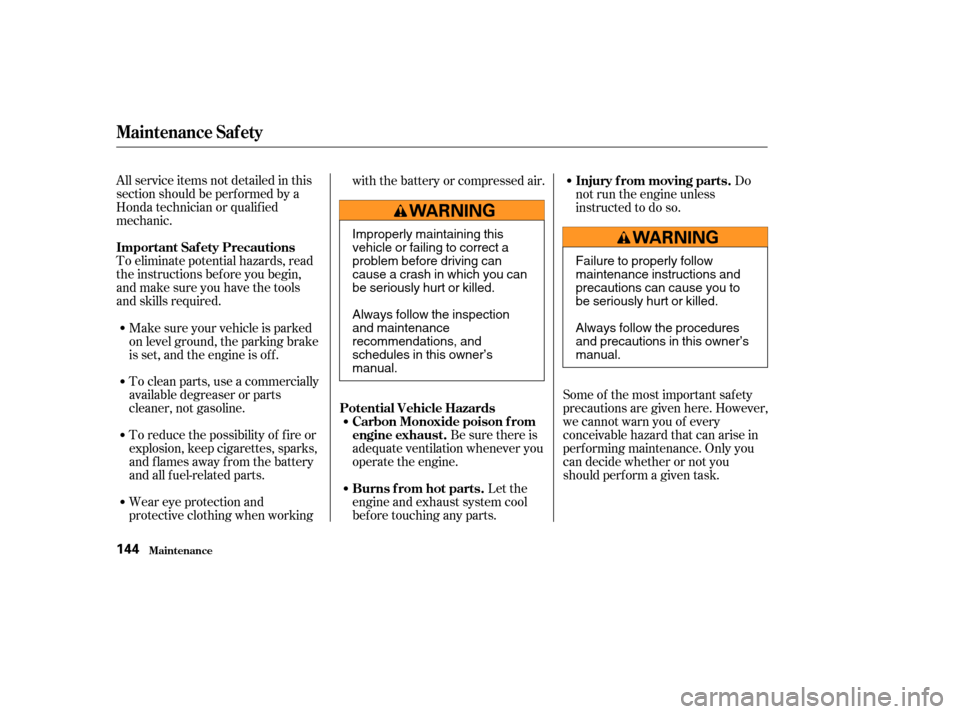Page 120 of 231
Park the vehicle, and set the
parking brake. Pull the hood
release handle located under the
lower lef t corner of the dashboard.
The hood will pop up slightly.
Put your f ingers between the f ront
edge of the hood and the f ront
grille. The hood latch handle is
above the ‘‘H’’ logo. Push this
handle up until it releases the
hood. Lif t the hood.If the hood latch handle moves
stif f ly, or if you can open the hood
without lifting the handle, the
mechanism should be cleaned and
lubricated.
Lif t it up slightly to remove the
support rod f rom the hole. Put the
support rod back into its holding clip.
Lower the hood to about a f oot (30
cm) above the f ender, then let it
drop. Make sure it is securely
latched.
Pull the support rod out of its clip,
and insert the end into the hole on
the f ront lef t side of the hood.
2. 1.
3.
Opening the Hood
T o Close the Hood
Service Station Procedures
Bef ore Driving117
HOOD
RELEASE
HANDLELATCH
GRIP
SUPPORT ROD CLIP
Page 130 of 231
This section gives you tips on
starting the engine under various
conditions, and how to operate the
5-speed manual and automatic
transmissions. It also includes impor-
tant inf ormation on parking your
vehicle, and the braking system.........................
Preparing to Drive .128
.......................
Starting the Engine .129
....
5-speed Manual Transmission . 130
.
Automatic Transmission (CVT) . 133
...........................................
Parking .139
.............................
Braking System .140
...............
Anti-lock Brakes (ABS) . 141
...........................
Towing a Trailer .142
Driving
Driving127
Page 132 of 231

Apply the parking brake.
In cold weather, turn of f all
electrical accessories to reduce
the drain on the battery.
Push the clutch pedal down all the
way.
Make sure the shif t lever is in
Park. Press on the brake pedal.
Without touching the accelerator
pedal, turn the ignition key to the
START (III) position. Do not hold
the key in START for more than
15 seconds at a time. If the engine
does not start right away, pause
f or at least 10 seconds bef ore
trying again.If the engine does not start within
15 seconds, or starts but stalls
right away, repeat step 4 with the
accelerator pedal pressed halfway
down. If the engine starts, release
pressure on the accelerator pedal
so the engine does not race.
If the engine fails to start, press
the accelerator pedal all the way
downandholdittherewhile
starting to clear flooding. If the
engine still does not start, return
to step 5.
In cold weather, conventional starter
is used instead of the IMA system
starter. This is normal. The engine is
also harder to start at altitudes above
8,000 f eet (2,400 meters) because of
the thinner air.
1.
2.
3.
4. 5.
6.
Manual Transmission:
Automatic Transmission (CVT)
Starting the Engine
Driving
Starting in Cold Weather
129
Page 139 of 231
Insert the key in the Shift Lock
Release slot.Remove the key from the Shift
Lock Release slot, then reinstall
thecover.Makesurethenotchon
the cover is on the lef t side.
Return the key to the ignition
switch, press the brake pedal, and
restart the engine.
If you need to use the Shif t Lock
Release, it means your vehicle is
developing a problem. Have it
checked by a Honda dealer.
Push down on the key while you
pressthereleasebuttononthe
shif t lever and move the shif t lever
out of Park to Neutral.
Do this if pushing on the brake pedal
and pressing the release button do
not shif t the transmission out of
Park:
Put a cloth on the edge of the Shif t
Lock Release slot cover next to
theshiftlever.Useakeyto
remove the cover. Caref ully pry on
the edge of the cover. Remove the key from the ignition
switch. Set the Parking brake.
1.
2.
3.
4.
5.6.
Shif t L ock Release
Automatic Transmission (CVT)
Driving136
RELEASE BUTTON
SHIFT LOCK
RELEASE SLOT
COVER
Page 142 of 231

Always use the parking brake when
you park your vehicle. Make sure
the parking brake is set f irmly or
your vehicle may roll if it is parked
on an incline.
If your vehicle has an automatic
transmission, set the parking brake
bef ore you put the transmission in
Park. This keeps the vehicle f rom
moving and putting pressure on the
parking mechanism in the
transmission.Make sure the windows are closed.
Turn of f the lights.
Place any packages, valuables, etc.
in the trunk or take them with you.
Lock the doors.
Never park over dry leaves, tall
grass, or other f lammable
materials. The hot three way
catalytic converter could cause
these materials to catch on fire.
If the vehicle is f acing uphill, turn
the f ront wheels away f rom the
curb. If you have a manual
transmission, put it in f irst gear.If the vehicle is f acing downhill,
turn the front wheels toward the
curb. If you have a manual
transmission, put it in reverse gear.
Make sure the parking brake is
f ully released bef ore driving away.
Driving with the parking brake
partially set can overheat or
damage the rear brakes.
Parking T ips
Parking
Driving139
Page 147 of 231

All service items not detailed in this
section should be perf ormed by a
Honda technician or qualif ied
mechanic.
To eliminate potential hazards, read
the instructions bef ore you begin,
and make sure you have the tools
and skills required.To clean parts, use a commercially
available degreaser or parts
cleaner, not gasoline.
To reduce the possibility of f ire or
explosion, keep cigarettes, sparks,
and f lames away f rom the battery
and all f uel-related parts.
Wear eye protection and
protective clothing when working with the battery or compressed air.
Be sure there is
adequate ventilation whenever you
operate the engine.
Let the
engine and exhaust system cool
bef ore touching any parts. Do
not run the engine unless
instructed to do so.
Some of the most important saf ety
precautions are given here. However,
we cannot warn you of every
conceivable hazard that can arise in
perf orming maintenance. Only you
can decide whether or not you
should perf orm a given task.
Make sure your vehicle is parked
on level ground, the parking brake
is set, and the engine is of f .
Maintenance Saf ety
Maint enance
Important Saf ety Precautions
Potential Vehicle HazardsCarbon Monoxide poison f rom
engine exhaust.
Burns f rom hot parts. Injury f rom moving parts.
144
Failure to properly follow
maintenance instructions and
precautions can cause you to
be seriously hurt or killed.
Always follow the procedures
and precautions in this owner’s
manual.
Improperly maintaining this
vehicle or failing to correct a
problem before driving can
cause a crash in which you can
be seriously hurt or killed.
Always follow the inspection
and maintenance
recommendations, and
schedules in this owner’s
manual.
Page 149 of 231

�Ì�µ
�µ
�µ
�µ
�µ �µ
Your authorized Honda dealer
knows your vehicle best and can
provide competent, ef f icient service.
However, service at a dealer is not
mandatory to keep your warranties
in effect. Maintenance may be done
by any qualif ied service f acility or
skilled person to keep your
warranties in ef f ect. Keep all the
receipts as proof of completion, and
have the person who does the work
f ill out the Maintenance Record.
Check your warranty booklet f or
more inf ormation.
We recommend the use of Honda
parts and f luids whenever you have
maintenance done. U.S. Vehicles:
According to state and federal
regulations, f ailure to perf orm
maintenance on the items marked
with will not void your emissions
warranties. However, Honda
recommends that all maintenance
services be perf ormed at the
recommended time or mileage
period to ensure long-term reliability.
Youshouldcheckthefollowing
items at the specif ied intervals. If
you are unsure of how to perf orm
any check, turn to the appropriate
page listed.
Engine oil level Check every
time you fill the fuel tank. See
page .
Engine coolant level Check the
radiator reserve tank every time
you f ill the f uel tank. See page .
Brakes Check the f luid level
monthly. See page .
Tires Check the tire pressure
monthly. Examine the tread f or
wear and foreign objects. See page .
Lights Check the operation of
the headlights, parking lights,
taillights, high-mount brake light,
and license plate lights monthly.
See page . Automatic transmission (CVT)
Check the f luid level monthly. See
page . 118
118
158 160
169
161
Maintenance Schedule
Maint enance
Servicing Your Vehicle Maintenance, replacement, or
repair of emissions control
devices and systems may be done
by any automotive repair
establishment or individual using
parts that are ‘‘certif ied’’ to EPA
standards.Owner’s Maintenance Checks
146
Page 150 of 231

�Ì
�Î �Î�Ì �Ì
�Î
�Î
�µ
Follow the Normal Maintenance
Schedule if the severe driving
conditions specif ied in the Severe
Conditions Maintenance Schedule on
the next page do not apply.
NOT E: If you only OCCASIONALLY
drive under a ‘‘severe’’ condition, you
should f ollow the Normal Conditions
Maintenance Schedule.
Follow the
Maintenance Schedule f or Severe
Conditions.
Maint enance
Canadian Owners
147
miles x 1,000
km x 1,000
Service the items listed at the indicated distance (or time, if given).
( (
O
O t
th
h e
er
rw
w i
is
se e a
ad
d j
ju
u s
stt o
o n
nl
ly
y i
if
f n
n o
oi
is
sy y )
)
Every 10,000 miles (16,000 km)(
(O
O r
re
ev
ve
er
ry
y 1
1y
ye
ea
ar
r,
, w
w h
hi
ic
ch h e
ev
ve
er
r c
coo m
m e
es
s f
fi
ir
r s
st t)
)
Check inflation and condition once a month Check oil and coolant at each fuel stop
10
16
20
32 40
6450
80 70
112 80
128 100
160
( (
O
O r
re
ev
ve
er
ry
y 2
2y
ye
ea
ar
rs
s, , w
w h
hi
ic
ch h e
ev
ve
er
r c
coo m
m e
es
s f
fi
ir
r s
st t)
)
130
208 140
224
( (
O
O r
re
ev
ve
er
ry
y 1
1y
ye
ea
ar
r,
, w
w h
hi
ic
ch h e
ev
ve
er
r c
coo m
m e
es
s f
fi
ir
r s
st t)
)
Every 160,000 miles (256,000 km)
30
48
60
96
( (
O
O r
re
ev
ve
er
ry
y 6
6y
ye
ea
ar
rs
s, , w
w h
hi
ic
ch h e
ev
ve
er
r c
coo m
m e
es
s f
fi
ir
r s
st t)
)
120
192
90
144 150
240
( (
O
O r
re
ev
ve
er
ry
y 2
2y
ye
ea
ar
rs
s, , w
w h
hi
ic
ch h e
ev
ve
er
r c
coo m
m e
es
s f
fi
ir
r s
st t)
)
See information on maintenance and
emission warranty on page .
At 120,000 miles (192,000 km) or 10 years, then every 60,000 miles (96,000 km) or 5 years
Every 3 years (independent of mileage) 110
176
Check engine oil and coolant
Check tires
Replace engine oil
Rotate tires (follow pattern on page 172)
Replace engine oil filter
Check front and rear brake wear
Check parking brake adjustment
Inspect the following items: Tie rod ends, steering gear box, and boots
Suspension components
Driveshaft boots
Brake hoses and lines (including ABS)
All fluid levels and condition of fluids
Exhaust system
Fuel lines and connections
Inspect and adjust drive belts
Replace dust and pollen filter
Replace air cleaner element
Replace spark plugs
Inspect valve clearance
Replace CVT fluid
Replace manual transmission fluid
Inspect idle speed
Inspect idle speed
Replace engine coolant
Replace brake fluid :
1: 2: For ULEV model 146
For AT-PZEV model
1
2
Maintenance Schedule for Normal Conditions